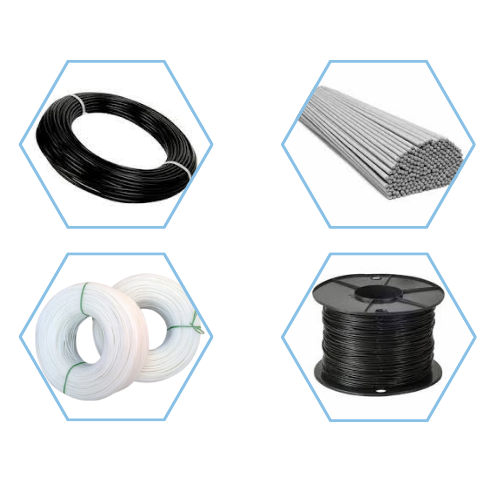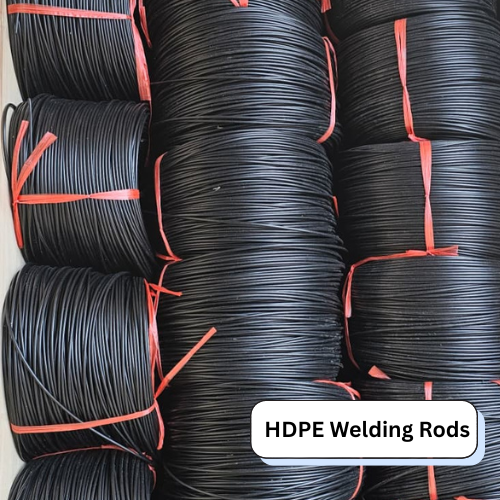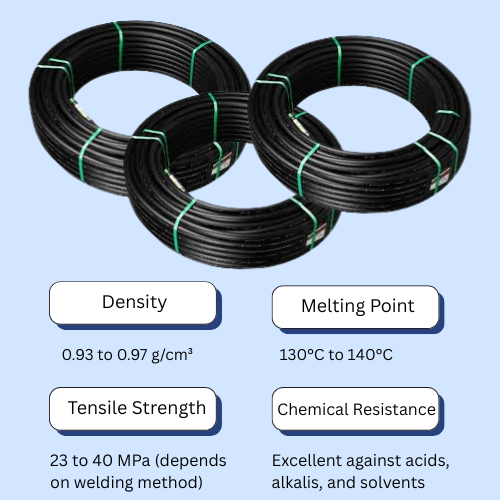What are HDPE Welding Rods?
HDPE welding rods are an essential tool for combining high-density polyethylene materials in processes such as plastic manufacture, pipe installation, and industrial maintenance. The HDPE surface integrity is preserved by the strong, smooth welds that are guaranteed by the dependable bonding medium that these rods offer.
Premium high-density polyethylene is used to make HDPE welding rods, which provide outstanding durability, flexibility, and chemical resistance. They provide reliable performance and durable outcomes, whether they are utilized in heavy industrial environments, precision fabrication shops, or on-site building projects.
Available in a range of diameters and colours, HDPE welding rods meet the demands of diverse industries. They are compatible with both manual hot-air welding tools and automated extrusion welders, making them versatile for various welding techniques.
Features
HDPE welding rods are designed for strong and durable welds in industrial and engineering applications. Here’s what makes them reliable:
- Chemical Resistance: HDPE welding rods resist most acids, alkalis, and chemicals, ensuring durability in harsh environments.
- Corrosion Resistance: They provide excellent resistance to corrosion, which extends the lifespan of the welded joints.
- UV Resistance: HDPE rods can withstand UV exposure, preventing degradation outdoors.
- Low Moisture Absorption: They maintain weld integrity even in humid or wet conditions.
- Flexibility: HDPE rods accommodate thermal expansion and contraction, reducing joint failure.
- Ease of Use: Compatible with common plastic welding tools such as hot air guns and extrusion welders.
- Strong Welds: Provide robust, seamless joints that match the mechanical properties of HDPE material.
- Temperature Resistance: Melt at about 190-230°C, suitable for typical HDPE welding processes.
- Dimensional Stability: Stay stable through temperature changes, maintaining joint strength.
What are its Applications?
HDPE welding rods are essential in a variety of industrial and commercial applications. In plastic tank fabrication, they are used to seal and join HDPE sheets for water storage tanks, chemical tanks, and process vessels, providing a secure and leak-proof finish. They ensure long-term dependability in piping systems by making strong connections in HDPE pipes for industrial fluids, sewage, and water supply. These rods are used in agriculture to bond HDPE components in irrigation systems, fertilizer tanks, and machinery, facilitating effective field operations, and in the marine industry to repair and reinforce sections found in boats, pontoons, and docks.
HDPE welding rods are essential for welding liners in ponds, canals, and landfills in the civil engineering and construction industries because they provide excellent resistance to environmental wear. The automotive and transportation sectors use them to fix HDPE parts like panel partitions and truck bed liners. In order to create unique HDPE structures, panels, and fittings that meet specific needs, they are also essential in custom fabrication.
How to Use?
Follow these basic measures to guarantee a successful weld.
- Select the Correct Rod – Ensure the rod diameter and grade match the HDPE material being welded.
- Clean the Surface – Remove dust, oil, and debris from the welding area for optimal bond strength.
- Preheat the Welding Tool: As per HDPE instructions, set the temperature to between 230°C and 270°C for hot air welding.
- Position the Rod: Line up the welding rod with the joint or area that has to be repaired.
- Apply Steady Heat: Heat the rod and the HDPE surface at the same time using the welding tip.
- Work in Controlled Motion: To guarantee consistent fusion and prevent overheating, move slowly.
- Examine Welds: Verify the joint’s uniformity, smoothness, and appropriate adhesion..
Safety Guidelines
- Always use heat-resistant gloves and protective eyewear.
- Use welding equipment in a well-ventilated environment to prevent fume inhalation.
- Maintain the right temperature for your tools to prevent burns or equipment damage.
- For the best quality weld, keep rods clean of dust, moisture, and oil.
- Do not attempt welding near flammable materials.
- Store rods in their original packaging to avoid contamination.




